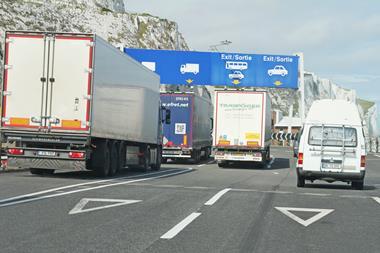Forget television. If you want to reach a mass audience the most effective media delivery channel is the supermarket. Think about it. You have a captive audience that visits regularly and is in shopping mode, so receptive to your message. Rather than 200-plus TV channels to choose from, retail consolidation means you can reach about 70% of the population using four supermarket chains. In fact, you can target even more precisekly because 500 stores are responsible for half of all grocery sales and loyalty card data gives you detailed information on potential buyers.
As for costs, earlier this year industry association Point of Purchase Advertising International (POPAI) unveiled research on advertising cost per 1,000 people which put PoP advertising at $5.50-7.50 (a two-week execution) while a 30-second commercial came in at $19-24 (see below).
Figures from POPAI UK show that 25% of consumer purchasing decisions are pre-planned while a whopping 75% of decisions are made in store. Yet more than 95% of ad spend goes out of store, with a measly 4.7% spent on PoP advertising. Gwen Morrison, North America/Canada president of WPP's global retail practice The Store, describes it as "the unpurchased media".
Recently, however, major brand manufacturers have woken up and instore advertising is fast moving up the marketing department's agenda.
"With the TV market fragmented, branded PoS material is becoming much more powerful," says Procter & Gamble national account manager Tom Pickford, citing the launch of Pringles curry flavour, which used pictorial shelf barkers. "In surveys, when asked where consumers first heard about it, the PoS ratings were up there with TV," he says.
Burton Foods' category development controller Philippe Roucoule says a third of the launch budget for Cadbury's Mighty Minis was spent in store  a seven figure sum. "Above the line does not deliver the incremental uplift."
At a TV conference earlier this year Nestlé ’owntree marketing director Andrew Harrison went one step further, calling supermarkets the "new media". In a later newspaper article he said: "Supermarkets have replaced TV as the delivery channel for the mass audience. If I want to get my message across to 70% of British households it is obviously going to be more cost-effective to run display ends in major retailers than to purchase overpriced breaks in a soap."
But there is just one tiny problem. The supermarkets themselves. For the past year the major chains have implemented strategies to clean up their stores. Anti-congestion, clutter-free, clear aisle policies  call it what you will  are hindering brand marketers' dreams of decking the store with a plethora of advertising material.
Generally the chains have targeted freestanding display units and dump bins. These, they say, clog up the aisles, making it difficult for customers to navigate; they look untidy, especially since they get damaged by trolleys and by cleaning; they detract from the retailer's own branded messages, and basically ruin the aesthetic of the store.
"We have focused on improving store standards, particularly clutter. Stores have been clutter-free over the past 12 months," Asda president and chief executive Tony DeNunzio said this summer while Somerfield associate director, marketing, Richard Smith told seminar delegates the company had cleared most supplier material to focus on its own message. "We had visual pollution, a poor brand image, cluttered aisles and unclear messages."
The Co-operative Group also restricts third party branded material. "We aim to ensure we keep supplier material to a maximum of 10 promotions per period in our market town stores. We accept supplier branded display stands, on shelf PoS and, in exceptional cases, posters. No hanging material is allowed," says a spokeswoman.
Brand marketers hoping to get their message through face the anti-congestion police, the people in head office who monitor what supplier branded material goes in store.
"There are strict policies, with a team managing PoP quantity and quality," says Jenny Gough of Litmus Research, which works with Sainsbury to identify the value of instore marketing. "Nothing can get through the back door."
But, if the figures are correct, retailers are surely losing sales by removing supplier advertising. In a trial last year Sainsbury took out hanging PoP from six stores. According to PoS project manager Jake Kirkham, there was little short-term effect but three months later sales dipped outside the confidence level. He believes hanging PoP is worth up to 2% of incremental sales, a "fairly significant" figure.
PoP industry players are sanguine about clear aisle policies. History has taught them it is cyclical. "Head office says clear the decks, all PoP is removed and then a year later it is back again," says Dave Corben, business development manager at Bezier which produces PoP material for Asda, Scottish Courage and Matthew Clark. He points out that many store managers do not abide by the rules anyway as they see a drop in sales without support.
Retailers spend millions of pounds a year on their own PoP advertising. In doing so they are admitting it influences customers. The key for brand marketers is to understand their requirements, says Gough.
"A brand puts huge effort into launching a product to ensure it is in every shop at the right price. Then the same team comes in with a secondary display and has no idea what shop it is in; it is the wrong shelf height; sticks out in the aisle or won't fit on chillers," she says. "The onus is on suppliers to understand the formats and get more standard kit. They need brand managers on display and PoP. "
Siemon Scamell-Katz, chairman of retail researcher ID Magasin, says brand owners are increasingly looking at channel management. "The more sophisticated companies are spending serious money researching it. It could be the best place for a soft drinks brand to communicate is in the convenience channel rather than supermarket as it offers better implementation and flexibility."
And he believes retailers are changing. "We spoke to one of the top three players recently and they said they were probably the number one media channel. The light bulbs are going on and pound signs are appearing."
{{ANALYSIS }}
As for costs, earlier this year industry association Point of Purchase Advertising International (POPAI) unveiled research on advertising cost per 1,000 people which put PoP advertising at $5.50-7.50 (a two-week execution) while a 30-second commercial came in at $19-24 (see below).
Figures from POPAI UK show that 25% of consumer purchasing decisions are pre-planned while a whopping 75% of decisions are made in store. Yet more than 95% of ad spend goes out of store, with a measly 4.7% spent on PoP advertising. Gwen Morrison, North America/Canada president of WPP's global retail practice The Store, describes it as "the unpurchased media".
Recently, however, major brand manufacturers have woken up and instore advertising is fast moving up the marketing department's agenda.
"With the TV market fragmented, branded PoS material is becoming much more powerful," says Procter & Gamble national account manager Tom Pickford, citing the launch of Pringles curry flavour, which used pictorial shelf barkers. "In surveys, when asked where consumers first heard about it, the PoS ratings were up there with TV," he says.
Burton Foods' category development controller Philippe Roucoule says a third of the launch budget for Cadbury's Mighty Minis was spent in store  a seven figure sum. "Above the line does not deliver the incremental uplift."
At a TV conference earlier this year Nestlé ’owntree marketing director Andrew Harrison went one step further, calling supermarkets the "new media". In a later newspaper article he said: "Supermarkets have replaced TV as the delivery channel for the mass audience. If I want to get my message across to 70% of British households it is obviously going to be more cost-effective to run display ends in major retailers than to purchase overpriced breaks in a soap."
But there is just one tiny problem. The supermarkets themselves. For the past year the major chains have implemented strategies to clean up their stores. Anti-congestion, clutter-free, clear aisle policies  call it what you will  are hindering brand marketers' dreams of decking the store with a plethora of advertising material.
Generally the chains have targeted freestanding display units and dump bins. These, they say, clog up the aisles, making it difficult for customers to navigate; they look untidy, especially since they get damaged by trolleys and by cleaning; they detract from the retailer's own branded messages, and basically ruin the aesthetic of the store.
"We have focused on improving store standards, particularly clutter. Stores have been clutter-free over the past 12 months," Asda president and chief executive Tony DeNunzio said this summer while Somerfield associate director, marketing, Richard Smith told seminar delegates the company had cleared most supplier material to focus on its own message. "We had visual pollution, a poor brand image, cluttered aisles and unclear messages."
The Co-operative Group also restricts third party branded material. "We aim to ensure we keep supplier material to a maximum of 10 promotions per period in our market town stores. We accept supplier branded display stands, on shelf PoS and, in exceptional cases, posters. No hanging material is allowed," says a spokeswoman.
Brand marketers hoping to get their message through face the anti-congestion police, the people in head office who monitor what supplier branded material goes in store.
"There are strict policies, with a team managing PoP quantity and quality," says Jenny Gough of Litmus Research, which works with Sainsbury to identify the value of instore marketing. "Nothing can get through the back door."
But, if the figures are correct, retailers are surely losing sales by removing supplier advertising. In a trial last year Sainsbury took out hanging PoP from six stores. According to PoS project manager Jake Kirkham, there was little short-term effect but three months later sales dipped outside the confidence level. He believes hanging PoP is worth up to 2% of incremental sales, a "fairly significant" figure.
PoP industry players are sanguine about clear aisle policies. History has taught them it is cyclical. "Head office says clear the decks, all PoP is removed and then a year later it is back again," says Dave Corben, business development manager at Bezier which produces PoP material for Asda, Scottish Courage and Matthew Clark. He points out that many store managers do not abide by the rules anyway as they see a drop in sales without support.
Retailers spend millions of pounds a year on their own PoP advertising. In doing so they are admitting it influences customers. The key for brand marketers is to understand their requirements, says Gough.
"A brand puts huge effort into launching a product to ensure it is in every shop at the right price. Then the same team comes in with a secondary display and has no idea what shop it is in; it is the wrong shelf height; sticks out in the aisle or won't fit on chillers," she says. "The onus is on suppliers to understand the formats and get more standard kit. They need brand managers on display and PoP. "
Siemon Scamell-Katz, chairman of retail researcher ID Magasin, says brand owners are increasingly looking at channel management. "The more sophisticated companies are spending serious money researching it. It could be the best place for a soft drinks brand to communicate is in the convenience channel rather than supermarket as it offers better implementation and flexibility."
And he believes retailers are changing. "We spoke to one of the top three players recently and they said they were probably the number one media channel. The light bulbs are going on and pound signs are appearing."
{{ANALYSIS }}















No comments yet